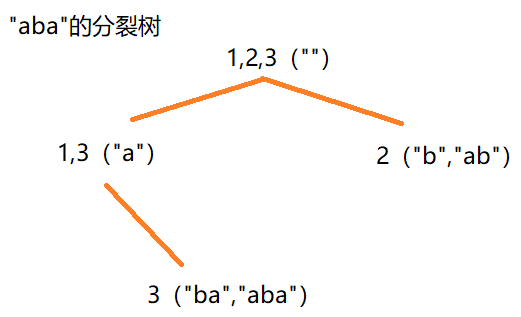前置知识 后缀自动机(Suffix-Automaton)
在自动机上游走 从$root$开始,沿目标字符串逐个字符走。若路径存在,即当前子串存在;反之,若出边不存在,即目标子串不存在。
求最小表示 求字符串$S$的最小表示。
度娘有$O(n)$的特殊做法,此处不赘述。
构造字符串$SS$的后缀自动机,从$root$开始,每次沿最小的出边走,走n步就得到了$SS$中长度为n的最小子串,即$S$的最小表示。
求本质不同的第k小子串 SPOJ SUBLEX 题意:求字符串$S$的所有本质不同子串中的第$k$小。$length(S)\le 9e4, 询问数量\le 500$。
SAM构造完成后得到一个DAG,利用拓扑序求从每个点出发可能的路径数目。见拓扑排序的方法 。最后用类似二分法求第k小即可。
1 2 3 4 5 6 7 8 9 10 11 12 13 14 15 16 17 18 19 20 21 22 23 24 25 26 27 28 29 30 31 32 33 34 35 36 37 38 39 40 41 42 43 44 45 46 47 48 49 50 51 52 53 54 55 56 57 58 59 60 61 62 63 64 65 66 67 68 69 70 71 72 73 74 75 76 77 78 79 80 81 82 83 84 85 86 87 88 89 90 91 92 93 94 95 96 97 98 99 100 101 102 103 104 105 106 107 108 109 110 111 #include <algorithm> #include <iostream> #include <cstring> using namespace std;const int MAXW = 26 , MAXN = 9e4 +5 ;struct State { State *pa; State *go[MAXW]; int Max; int siz = 1 ; static int cnt; }sam[MAXN<<1 ], *last, *root; State* alloc (int Max) { State& ref = sam[State::cnt++]; ref.Max = Max; return &ref; } State* alloc (State* src) { State& ref = sam[State::cnt++]; ref = *src; return &ref; } void extend (int c) State *p = last, *np = alloc (p->Max+1 ); last = np; while (p && !p->go[c]) p->go[c] = np, p = p->pa; if (!p) return np->pa = root, void (); State* q = p->go[c]; if (q->Max == p->Max+1 ) return np->pa = q, void (); State* nq = alloc (q); nq->Max = p->Max + 1 ; q->pa = np->pa = nq; while (p && p->go[c] == q) p->go[c] = nq, p = p->pa; } int State::cnt = 0 ;char st[MAXN];int Q, len;int num[MAXN];State* b[MAXN<<1 ]; void dfs (const State* now, int dep, int lef) static char ans[MAXN]; if (lef == 0 ) { ans[dep] = '\0' ; puts (ans); return ; } for (int i=0 ; i<MAXW; ++i) if (now->go[i]) { const State* g = now->go[i]; if (lef <= g->siz) { ans[dep] = i+'a' ; return dfs (g, dep+1 , lef-1 ); } else { lef -= g->siz; } } } int main () #ifdef DEBUG freopen ("in" , "r" , stdin); #endif last = root = alloc (0 ); scanf ("%s" , st); for (int &i=len; st[i]!='\0' ; ++i) { st[i] -= 'a' ; extend (st[i]); } for (int i=0 ; i<State::cnt; ++i) ++num[sam[i].Max]; for (int i=len-1 ; i>=0 ; --i) num[i] += num[i+1 ]; for (int i=0 ; i<State::cnt; ++i) b[--num[sam[i].Max]] = &sam[i]; for (int i=0 ; i<State::cnt; ++i) for (int j=0 ; j<MAXW; ++j) if (b[i]->go[j]) b[i]->siz += b[i]->go[j]->siz; scanf ("%d" , &Q); while (Q--) { int aim; scanf ("%d" , &aim); dfs (root, 0 , aim); } return 0 ; }
离线计算|Right| 构造好的后缀自动机隐含了一颗分裂树,只需访问所有节点和$Pa$指针,就能还原这颗分裂树。显然,叶子节点的$|Right| = 1$,但仅有这些信息还不足推出其他节点的$|Right|$,这是因为节点在往下分裂时可能丢失元素
如上图所示,“1”在分裂的过程中消失了,不存在叶子节点中。
为什么$Right$集合的元素无法往下分裂?这是因为它表示的子串无法向左端扩展,换句话说,它是前缀。注意到叶子节点也是前缀。综上所述,只要对前缀所在节点的$|Right|$预置为$1$(其他节点预置为$0$),然后自底向上更新分裂树即可得到所有$|Right|$
分裂树上拓扑排序 上文引出了一个新问题,如何自底向上地访问分裂树?一种直观的办法是bfs收集SAM所有节点再做拓扑排序,这逻辑复杂而代码繁琐。一种更好的办法是,在构造SAM时采用内存池技术,之后对内存池按照$Max$降序排序即可。原因是后缀自动机的更多性质 。
拓扑排序要点
指针板构造采用内存池技术
$Max$可能的取值仅有$[1,n]$,所以要采用计数排序
不要真的修改内存池,而是新开指针做排序
如果不得不写常规拓扑排序,bfs时请注意DAG的重复访问
1 2 3 4 for (int i=0 ; i<cnt; ++i) ++num[sam[i].Max];for (int i=len-1 ; i>=0 ; --i) num[i] += num[i+1 ];for (int i=0 ; i<cnt; ++i) b[--num[sam[i].Max]] = &sam[i];
剩余细节在例题1 、例题2 中体现
求长度为i的子串的最大出现次数 SPOJ NSUBSTR 题意:给出字符串S(长度<=2.5e5),设f(x)为S中长度为x的子串的最大出现次数,求f(1...length(s))。
分析:后缀自动机中每个状态$s$蕴含的字符串长度为$[Min(s), Max(s)]$,每个出现了$Right(s)$次,只需用$|Right(s)|$更新$ans[Max(s)]$就行了,在最后输出前依次用$ans[i+1]$更新$ans[i]$即可。原因是长度更长的子串出现的次数一定不超过长度短的。
1 2 3 4 5 6 7 8 9 10 11 12 13 14 15 16 17 18 19 20 21 22 23 24 25 26 27 28 29 30 31 32 33 34 35 36 37 38 39 40 41 42 43 44 45 46 47 48 49 50 51 52 53 54 55 56 57 58 59 60 61 62 63 64 65 66 67 68 69 70 71 72 73 74 75 76 77 78 79 80 81 82 83 84 85 86 87 88 89 90 91 92 93 94 95 96 97 98 99 100 101 102 103 104 105 106 107 108 109 110 111 112 113 114 115 116 117 118 119 120 121 122 123 124 125 126 127 128 #include <algorithm> #include <iostream> #include <cstring> using namespace std;#ifdef DEBUG const int MAXW = 26 , MAXN = 50 +3 ;#else const int MAXW = 26 , MAXN = 250000 +3 ;#endif struct State { State* pa; State* go[MAXW]; int Max; int RSiz = 0 , inD = 0 ; bool vis = false ; State (int Max) { memset (go, 0 , sizeof (go)); pa = nullptr ; this ->Max = Max; } State (const State* o) { memcpy (go, o->go, sizeof (go)); pa = o->pa; Max = o->Max; } }*root, *last; void extend (int c) State *p = last, *np = new State (p->Max+1 ); last = np; while (p && !p->go[c]) p->go[c] = np, p = p->pa; if (!p) return np->pa = root, void (); State *q = p->go[c]; if (p->Max+1 == q->Max) return np->pa = q, void (); State *nq = new State (q); q->pa = np->pa = nq; nq->Max = p->Max + 1 ; while (p && p->go[c] == q) p->go[c]=nq, p = p->pa; } char st[MAXN];int len;State* q[MAXN<<1 ]; int cnt = 0 ;void bfs () q[0 ] = root; cnt = 1 ; for (int i=0 ; i<cnt; ++i) { State* const now = q[i]; if (now->pa) ++now->pa->inD; for (int j=0 ; j<MAXW; ++j) if (now->go[j] && !now->go[j]->vis) { q[cnt++] = now->go[j]; now->go[j]->vis = true ; } } } void topsort () int head = 0 , tail = partition (q, q+cnt, [](const State* o) { return o->inD == 0 ; }) - q; while (head < tail) { State* now = q[head++]; if (!now->pa) continue ; now->pa->RSiz += now->RSiz; if (--now->pa->inD == 0 ) q[tail++] = now->pa; } } int ans[MAXN];int main () #ifdef DEBUG freopen ("in" , "r" , stdin); #endif root = last = new State (0 ); scanf ("%s" , st); for (int &i=(len=0 ); st[i]!='\0' ; ++i) { st[i] -= 'a' ; extend (st[i]); } bfs (); State* p = root; for (int i=0 ; i<len; ++i) { p = p->go[st[i]]; ++p->RSiz; } topsort (); for (int i=0 ; i<cnt; ++i) { ans[q[i]->Max] = max (ans[q[i]->Max], q[i]->RSiz); } for (int i=len; i>1 ; --i) ans[i-1 ] = max (ans[i-1 ], ans[i]); for (int i=1 ; i<=len; ++i) printf ("%d\n" , ans[i]); return 0 ; }
跳向父亲,舍弃左端,寻求匹配 now = now->pa的本质是抛弃左端一部分字符,带来的效果是$Right$集合的扩张。这个特性在求最长公共子串的时候尤为好用,与KMP舍弃右端部分字符以寻求匹配的原理有异曲同工之妙。
求两字符串的最长公共子串 SPOJ LCS 题意:求字符串$S1,S2$的最长公共子串(要求连续)
分析:后缀自动机很擅长处理连续串的匹配。试想我们做出$S1$的SAM,然后直接跑$S2$,势必出现出边不存在的问题——无法继续匹配了。不妨设无法继续匹配时,导致无法匹配的字符是$S2[i]$,当前状态为$s$,即$trans(s, S2[i])$不存在,即不存在$S1[r_j]=S2[i], r_j\in Right(s)$。想要寻求匹配,只能抛弃已匹配的子串左端,而s=s->pa恰好带来了最少的抛弃量,使得$Right(s)$能扩张,从而带来匹配的可能性。
换句话说,当s->go[S2[i]] == nullptr时,重复s = s->pa,直到获得匹配s->go[S2[i]] != nullptr或不可能匹配s == nullptr。
假如直接能匹配呢?那太简单了,匹配长度加一,下一位。
于是最终解为:记当前已匹配长度$match$,当前答案$ans$,当前自动机状态$s$,接下来尝试匹配$S2[i]$,若$trans(s,S2[i])$存在,就转移,并且$match$加一;否则尝试不断跳分裂树的$fa$,直到转移存在,由于$Max(fa) < Min(s) \le match$,$match$必能取到$Max(fa)$,所以$s$跳到$trans(fa, S2[i])$, $match$取为$Max(fa)+1$即可。每走一步都用$match$更新$ans$。
1 2 3 4 5 6 7 8 9 10 11 12 13 14 15 16 17 18 19 20 21 22 23 State* now = root; int match = 0 , ans = 0 ; for (int i=0 ; sb[i]!='\0' ; ++i) { const int c = (sb[i]-='a' ); if (now->go[c]) { now = now->go[c]; ++match; } else { while (now && !now->go[c]) now = now->pa; if (now) { match = now->Max+1 ; now = now->go[c]; } else { now = root; match = 0 ; } } ans = max (ans, match); }

